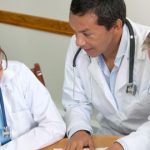In a follow-up study, a resident-directed intervention that encouraged residents to express an interest in discussing the case with the consultant during the consultation request and to elicit one teaching point from every new consultation increased in-person interactions and teaching between residents and fellows.9
3. Enhance Consultant Teaching Skills
Teaching during consultation can be challenging because it can be difficult to effectively assess the learner, determine teaching objectives and deliver useful teaching in the limited amount of time that consultants and primary teams have. Programs designed to improve consultants’ teaching skills, particularly in the areas of learner-centered teaching, rapid learner assessment and feedback, have the potential to improve consult interactions. For example, a fellow-as-clinical-teacher program at our institutions improved fellows’ teaching skills and interest in teaching more frequently during consultation.10 There is a strong interest among fellows for programs that focus on teaching skill development, although such programs are relatively rare during fellowship training [unpublished data from our institutions]. In addition, enhancing fellows’ teaching skills may have an impact on the teaching skills of future faculty.
Emphasizing the importance of teaching within a division is critical. In divisions that place little emphasis on teaching, fellows may have little motivation to teach, particularly when faced with multiple competing responsibilities. Fellows who work with attendings who put an emphasis on teaching have been noted to teach more.1 Methods of encouraging teaching within a division include participation of faculty in education scholarship and faculty development, conferences focusing on medical education, having teaching awards and setting expectations for teaching within the division.
4. Reduce Barriers to In-Person Communication Posed By the Hospital Environment
Hospital systems pose a number of barriers to effective communication. It can be difficult for the primary team and consultant to meet in person due to disparate work locations, schedules and lack of familiarity. Several interventions directed at improving hospital systems to facilitate in-person interactions have the potential to enhance communication:
Instituting regionalized medical teams, in which physicians are located on the same floor as their patients, makes it easier for consultants to locate the primary team. Enhancing familiarity between primary teams and consultants by providing photos in the paging directory and using the electronic medical record to enable parties to recognize and locate each other can also be effective. Familiarity between primary teams and consultants can also be developed via joint conferences, common work spaces, and departmental and social events. Finally, aligning primary team and consult team rounding schedules, as well as familiarizing consultants with primary team structure and rounding times and vice versa, can facilitate in-person communication.
5. Develop a Mechanism for Feedback Between Consultants & Primary Teams
Feedback and evaluation are important for optimal workplace performance. However, residents typically don’t participate in fellow evaluation and vice versa. Without effective feedback, consultants (and fellows in particular) lack the mechanism to improve their teaching and consultative skills. Although individual fellow evaluation by residents or hospitalists can be logistically difficult in large medical centers, we have recently developed an instrument that enables residents to evaluate internal medicine subspecialty consult services as a whole. The evaluation was well received and led to changes in fellowship curricula and consult service structure.11
Conclusion
Unlocking the full power of consult interactions requires not only addressing specific barriers but also culture change. The interventions described above, particularly if instituted together, have the potential to overcome barriers directly and to affect the inaccurate perceptions residents and fellows may hold that hinder consult interactions. More effective consult interactions lead to increased familiarity between consultants and primary teams, thus further breaking down barriers and compounding interventions’ positive effects.
